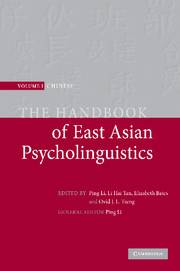Book contents
- Frontmatter
- Contents
- List of figures
- Notes on contributors
- Preface
- Introduction: new frontiers in Chinese psycholinguistics
- Part I Language acquisition
- Part II Language processing
- 14 Word-form encoding in Chinese speech production
- 15 Effects of semantic radical consistency and combinability on Chinese character processing
- 16 Eye movement in Chinese reading: basic processes and crosslinguistic differences
- 17 The Chinese character in psycholinguistic research: form, structure, and the reader
- 18 Perception and production of Mandarin Chinese tones
- 19 Phonological mediation in visual word recognition in English and Chinese
- 20 Reading Chinese characters: orthography, phonology, meaning, and the Lexical Constituency Model
- 21 Processing of characters by native Chinese readers
- 22 L2 acquisition and processing of Mandarin tones
- 23 The comprehension of coreference in Chinese discourse
- 24 Lexical ambiguity resolution in Chinese sentence processing
- Part III Language and the brain
- Epilogue: a tribute to Elizabeth Bates
- References
- Name index
- Subject index
20 - Reading Chinese characters: orthography, phonology, meaning, and the Lexical Constituency Model
Published online by Cambridge University Press: 05 June 2012
- Frontmatter
- Contents
- List of figures
- Notes on contributors
- Preface
- Introduction: new frontiers in Chinese psycholinguistics
- Part I Language acquisition
- Part II Language processing
- 14 Word-form encoding in Chinese speech production
- 15 Effects of semantic radical consistency and combinability on Chinese character processing
- 16 Eye movement in Chinese reading: basic processes and crosslinguistic differences
- 17 The Chinese character in psycholinguistic research: form, structure, and the reader
- 18 Perception and production of Mandarin Chinese tones
- 19 Phonological mediation in visual word recognition in English and Chinese
- 20 Reading Chinese characters: orthography, phonology, meaning, and the Lexical Constituency Model
- 21 Processing of characters by native Chinese readers
- 22 L2 acquisition and processing of Mandarin tones
- 23 The comprehension of coreference in Chinese discourse
- 24 Lexical ambiguity resolution in Chinese sentence processing
- Part III Language and the brain
- Epilogue: a tribute to Elizabeth Bates
- References
- Name index
- Subject index
Summary
The implications of Chinese for models of word reading
Models of word reading have come primarily from studies of English word identification, supplemented by studies of alphabetic writing systems for European languages. This is true both for symbolic models that postulate an internal lexicon and multiple pathways to pronunciation (Coltheart, 1978; Coltheart et al., 1993; Besner & Smith, 1992; Paap & Noel, 1991) and nonsymbolic models that assume a single mechanism without a lexicon (Harm & Seidenberg, 1999; Seidenberg & McClelland, 1989; Plaut et al., 1996; Van Orden, Pennington & Stone, 1990). Models that may extend beyond English (Berent & Perfetti, 1995; Grainger & Jacobs, 1994; Grainger & Jacobs, 1996; Jacobs et al., 1998) remain largely focused on alphabetic writing systems.
Research on reading in nonalphabetic writing systems, however, has accumulated sufficiently to invite comparisons with alphabetic reading. Both Japanese Kana, a syllabic system, and Chinese have been the focus of research. Because the Chinese system, as used in China and derivatively elsewhere in Southeast Asia (e.g. Japanese Kanji), presents the highest contrast to alphabetic systems, it provides an especially interesting comparison with alphabetic reading.
A focus on Chinese brings to light an important property of reading that may have been partially submerged by alphabetic research and its focus on routes to the lexicon and phonological mediation of meaning: that phonology is automatically activated in reading words, whether it is “before” or “after” some moment of lexical access and whether it is instrumental in retrieving the meaning of a word.
- Type
- Chapter
- Information
- The Handbook of East Asian Psycholinguistics , pp. 225 - 236Publisher: Cambridge University PressPrint publication year: 2006
- 21
- Cited by



